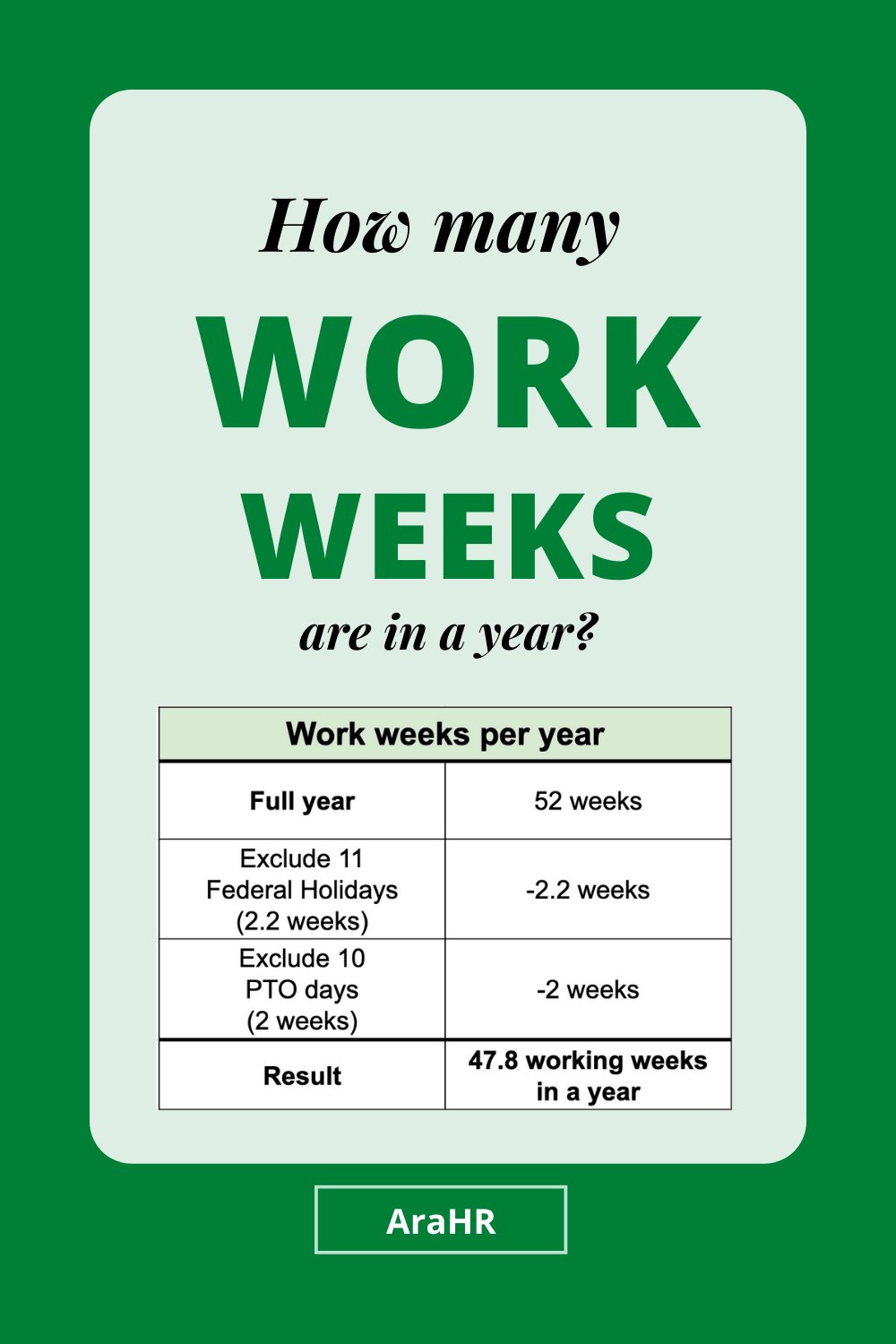“52 work weeks in a year.” The number may seem fixed, but have you ever delved deeper into understanding how many work weeks truly make up a year? Beyond the standard 52, factors like holidays, vacations, and part-time arrangements can all influence this calculation. Let’s unravel the complexities and nuances of ‘how many work weeks’ in a year, shedding light on what truly constitutes a work week and how it impacts our perception of time spent on the job. Let’s dive in and explore the intricacies of this fundamental aspect of our working lives.
Understanding How Many Work Weeks: A Comprehensive Guide
Have you ever wondered how many work weeks are in a year? Or maybe you’re curious about how many hours you spend working each week compared to others around the world? In this detailed guide, we will explore the concept of work weeks, break it down into manageable parts, and provide you with all the information you need to understand how time is counted in the world of work.
What is a Work Week?
Let’s start by defining what a work week actually means. A work week is a set period of seven consecutive days during which an employee is expected to complete their work duties. In most countries, the standard work week consists of five days, typically Monday to Friday, with weekends off. However, some industries or professions may have different schedules based on their specific needs.
Types of Work Weeks
There are various types of work weeks depending on the industry and company policy. Here are some common examples:
- Standard 40-Hour Work Week: This is the most common type of work week where employees work eight hours a day for five days, totaling 40 hours per week.
- Alternate Work Week: Some companies may have a different schedule, such as working longer hours for fewer days, like ten hours a day for four days.
- Flexible Work Week: In this type of work week, employees have the flexibility to choose their work hours within certain limits.
- Part-Time Work Week: Part-time employees work fewer hours per week compared to full-time employees, usually less than 40 hours.
Calculating Work Weeks in a Year
Now, let’s dive into the math behind calculating how many work weeks are in a year. Since there are 52 weeks in a year, a standard work week of five days amounts to roughly 52 work weeks in a year. However, this can vary depending on public holidays and the company’s vacation policy.
For example, if a company offers two weeks of vacation time and observes ten public holidays, the total number of work weeks would be reduced to 40 weeks in a year.
Factors Affecting Work Weeks
Several factors can affect the number of work weeks in a year, such as:
- Vacation Days: The more vacation days an employee has, the fewer work weeks there will be in a year.
- Public Holidays: Observing public holidays can reduce the total number of work weeks in a year.
- Company Policies: Different companies may have varying policies regarding work weeks and holidays.
Comparing Work Weeks Around the World
Have you ever wondered how your work week compares to those in other countries? Let’s take a look at the average number of work weeks in some countries around the world:
United States
In the United States, the standard work week is typically 40 hours, totaling 52 work weeks in a year. However, some employees may work more hours or have different schedules based on their job requirements.
France
France is known for its work-life balance, with a standard work week of 35 hours. This translates to roughly 44 work weeks in a year, giving French employees more time for leisure and relaxation.
Japan
Japan has a reputation for its strong work ethic, with many employees working long hours. The standard work week in Japan is around 40 hours, similar to the United States, resulting in 52 work weeks in a year.
Optimizing Your Work Weeks
Now that you have a better understanding of how work weeks are calculated and the variations around the world, it’s essential to optimize your own work weeks for productivity and well-being. Here are some tips to make the most of your work weeks:
Set Realistic Goals
Break down your tasks into manageable goals for each work week to stay on track and avoid feeling overwhelmed. Setting realistic goals will help you make progress without burning out.
Take Breaks
It’s crucial to take regular breaks throughout your work week to recharge and maintain focus. Schedule short breaks between tasks to refresh your mind and prevent fatigue.
Prioritize Tasks
Identify the most critical tasks for each work week and prioritize them based on deadlines and importance. Focus on completing high-priority tasks first to ensure you meet your objectives efficiently.
Practice Work-Life Balance
Remember to create a healthy balance between work and personal life to avoid stress and burnout. Make time for activities you enjoy outside of work to recharge and improve your overall well-being.
In Conclusion
Understanding how many work weeks are in a year and how work weeks vary around the world can provide valuable insights into how time is managed in different cultures and industries. By optimizing your work weeks through effective goal-setting, breaks, task prioritization, and work-life balance, you can enhance your productivity and overall satisfaction with your work. Remember, it’s not just about the quantity of work weeks but the quality of time you spend during those weeks that truly matters.
So, whether you’re counting down the work weeks until your next vacation or striving to make the most of each week, make sure to prioritize your well-being and work smartly to achieve your goals.
How Many Work Weeks Are In A Year? (It Depends)
Frequently Asked Questions
How many work weeks are in a typical month?
In general, a typical month consists of around 4.3 work weeks. This is because a standard work week is considered to be 40 hours spread across five working days.
What factors can affect the number of work weeks in a month?
The number of work weeks in a month can vary due to factors such as public holidays, company policies on working hours, and whether an employee works full-time or part-time. Additionally, leap years can also impact the number of work weeks in a given month.
Is it possible for a month to have more than five work weeks?
Yes, it is possible for a month to have more than five work weeks. This can occur if a month starts mid-week or if there are five full work weeks followed by a few days from the next month falling in the same week.
Final Thoughts
In conclusion, achieving work-life balance often requires intentional effort. By setting boundaries, prioritizing tasks, and delegating responsibilities, individuals can better manage their time and energy. This process typically takes several work weeks to establish new habits and routines. However, the long-term benefits of a balanced life make the initial effort worthwhile. Remember, finding the right balance is a journey that may require adjustments along the way. Prioritize self-care and well-being to sustain productivity and happiness over the course of many work weeks.




